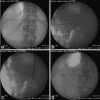Comparative Evaluation of Retrocrural versus Transaortic Neurolytic Celiac Plexus Block for Pain Relief in Patients with Upper Abdominal Malignancy: A Retrospective Observational Study
- PMID: 27559259
- PMCID: PMC4973491
- DOI: 10.4103/0973-1075.185041
Comparative Evaluation of Retrocrural versus Transaortic Neurolytic Celiac Plexus Block for Pain Relief in Patients with Upper Abdominal Malignancy: A Retrospective Observational Study
Abstract
Aim: To compare retrocrural versus transaortic techniques for neurolytic celiac plexus block (NCPB) in patients suffering from upper abdominal malignancy.
Methods: In this retrospective observational study between October 2013 and April 2015, 64 patients with inoperable upper abdominal malignancy received fluoroscopy-guided percutaneous NCPB in our institute. Their case files were reviewed and the patients were divided into two groups depending on the technique used to perform NCPB: retrocrural (Group R; n = 36) versus transaortic (Group T; n = 28). The primary outcome measure was pain as assessed with a numeric rating scale (NRS) from 0 to 10; the secondary outcome measures were morphine consumption per day (M), quality of life (QOL) as assessed by comparing the percent of positive responses in each group, and complications if any. These were noted and analyzed prior to intervention and then on day 1, weeks 1, 2, 3, and months 1, 2, 3, 6 following NCPB.
Results: Patients in Group R had significantly reduced NRS pain scores at week 1, 2, 3, month 1 and 2 as compared to Group T (P < 0.05). Morphine consumption also reduced significantly in Group R at day 1, week 1, 2, and 3 (P < 0.05). QOL was found to be comparable between the groups, and no major complications were noted.
Conclusion: Retrocrural NCPB provides superior pain relief along with a reduction in morphine consumption as compared to transaortic NCPB in patients with pain due to upper abdominal malignancy.
Keywords: Neurolytic celiac plexus block; Retrocrural; Transaortic; Upper abdominal cancer pain.
Figures




Similar articles
-
Low Volume Neurolytic Retrocrural Celiac Plexus Block for Visceral Cancer Pain: Retrospective Review of 507 Patients with Severe Malignancy Related Pain Due to Primary Abdominal Cancer or Metastatic Disease.Pain Physician. 2018 Sep;21(5):497-504. Pain Physician. 2018. PMID: 30282394
-
Combined neurolytic block of celiac and superior hypogastric plexuses for incapacitating upper abdominal cancer pain.J BUON. 2014 Jul-Sep;19(3):826-30. J BUON. 2014. PMID: 25261674 Clinical Trial.
-
Factors associated with successful response to neurolytic celiac plexus block in patients with upper abdominal cancer-related pain: a retrospective study.Korean J Pain. 2021 Oct 1;34(4):479-486. doi: 10.3344/kjp.2021.34.4.479. Korean J Pain. 2021. PMID: 34593666 Free PMC article.
-
Celiac plexus block in cancer pain management.Tohoku J Exp Med. 2000 Sep;192(1):1-18. doi: 10.1620/tjem.192.1. Tohoku J Exp Med. 2000. PMID: 11128864 Review.
-
Celiac plexus block: a reappraisal.Reg Anesth Pain Med. 1998 Jan-Feb;23(1):37-48. doi: 10.1016/s1098-7339(98)90109-2. Reg Anesth Pain Med. 1998. PMID: 9552777 Review.
Cited by
-
Effect of Celiac Plexus Neurolysis for Pain Relief in Patients with Upper Abdominal Malignancy: A Retrospective Observational Study and Review of Literature.Indian J Palliat Care. 2020 Oct-Dec;26(4):512-517. doi: 10.4103/IJPC.IJPC_37_20. Epub 2020 Nov 19. Indian J Palliat Care. 2020. PMID: 33623314 Free PMC article.
-
16. Pain in chronic pancreatitis.Pain Pract. 2025 Apr;25(4):e70030. doi: 10.1111/papr.70030. Pain Pract. 2025. PMID: 40189721 Free PMC article. Review.
-
Splanchnic nerve neurolysis via the transdiscal approach under fluoroscopic guidance: a retrospective study.Korean J Pain. 2022 Apr 1;35(2):202-208. doi: 10.3344/kjp.2022.35.2.202. Korean J Pain. 2022. PMID: 35354683 Free PMC article.
-
Celiac plexus block increases quality of life in patients with pancreatic cancer.J Pain Res. 2019 Jan 14;12:307-315. doi: 10.2147/JPR.S186659. eCollection 2019. J Pain Res. 2019. PMID: 30679920 Free PMC article.
References
-
- Polati E, Luzzani A, Schweiger V, Finco G, Ischia S. The role of neurolytic celiac plexus block in the treatment of pancreatic cancer pain. Transplant Proc. 2008;40:1200–4. - PubMed
-
- Morturano RA, Dunphy EP. Celiac plexus block in pancreatic neuroendocrine tumors. Clin J Oncol Nurs. 2011;15:218–20. - PubMed
-
- Nagels W, Pease N, Bekkering G, Cools F, Dobbels P. Celiac plexus neurolysis for abdominal cancer pain: A systematic review. Pain Med. 2013;14:1140–63. - PubMed
-
- Mercadante S, Klepstad P, Kurita GP, Sjøgren P, Giarratano A. European Palliative Care Research Collaborative (EPCRC). Sympathetic blocks for visceral cancer pain management: A systematic review and EAPC recommendations. Crit Rev Oncol Hematol. 2015;96:577–83. - PubMed
LinkOut - more resources
Full Text Sources
Other Literature Sources
Miscellaneous

